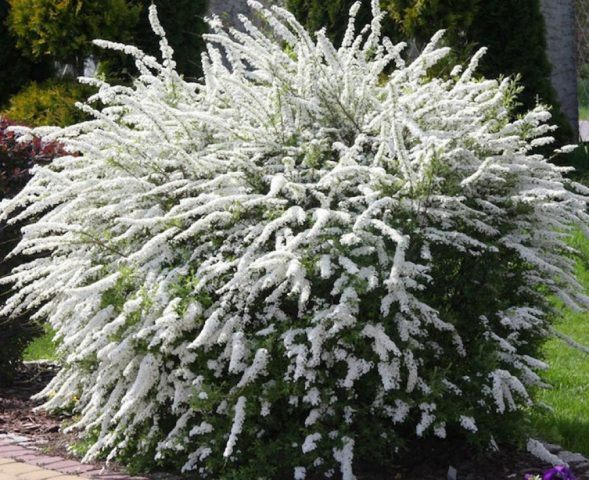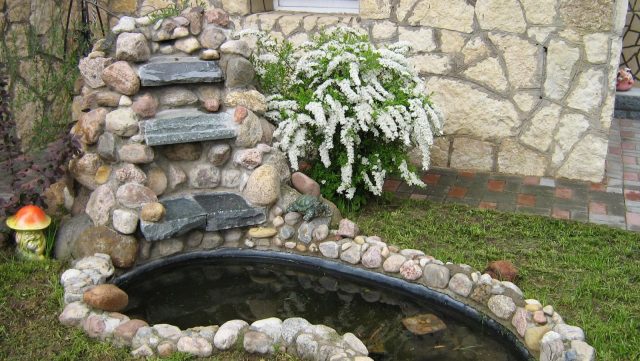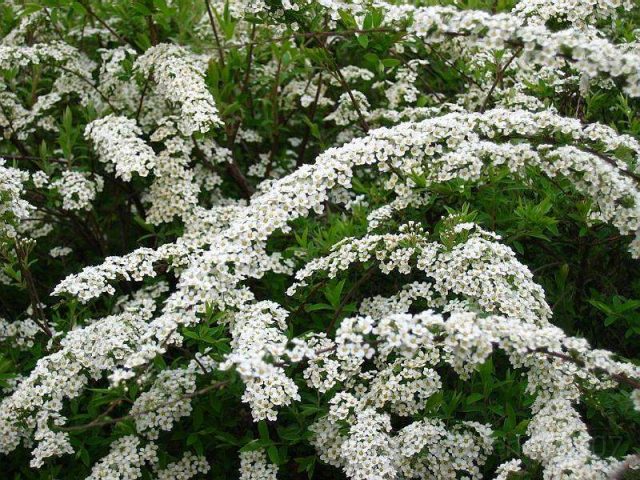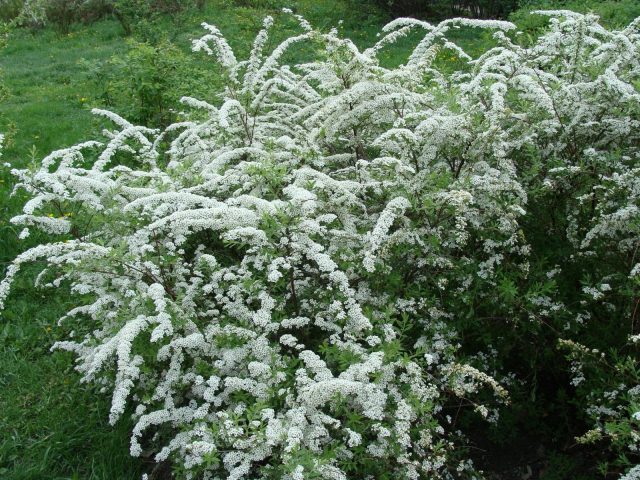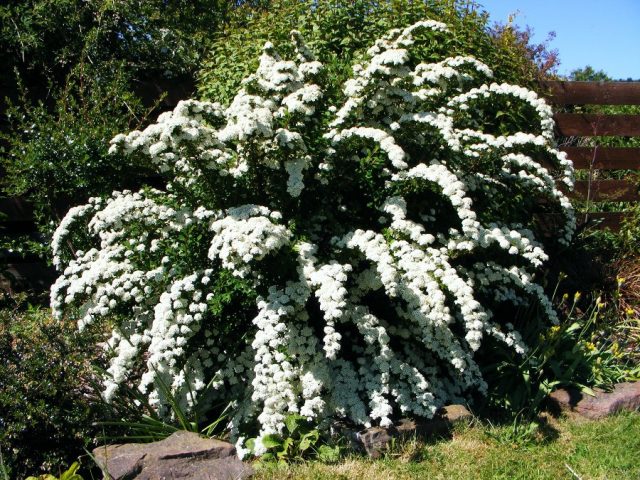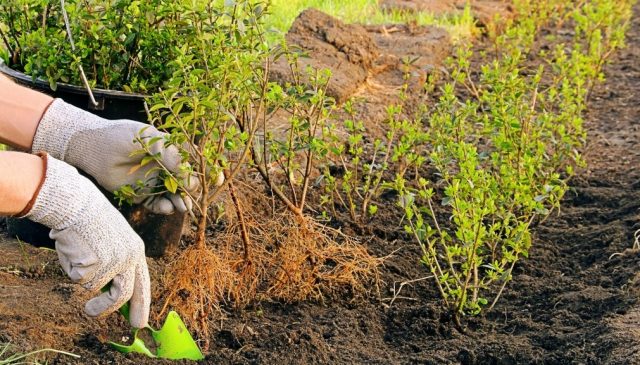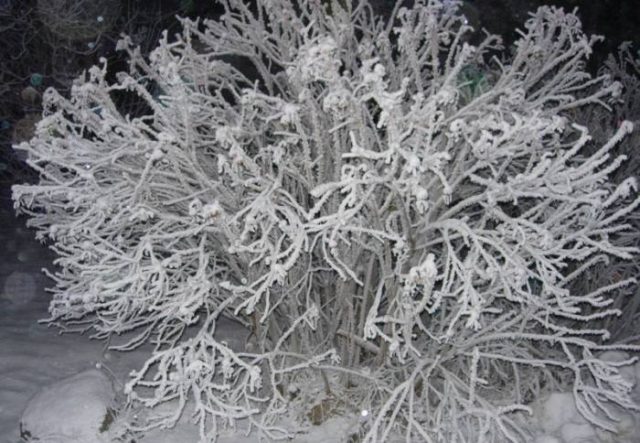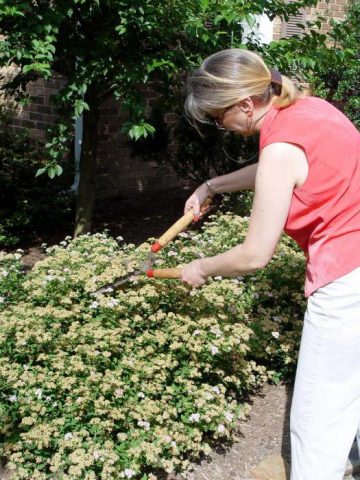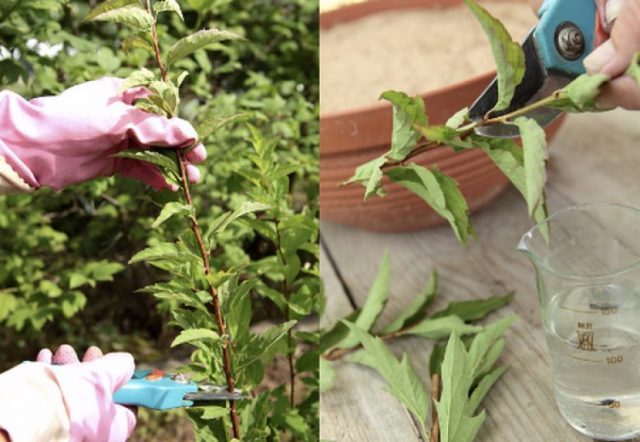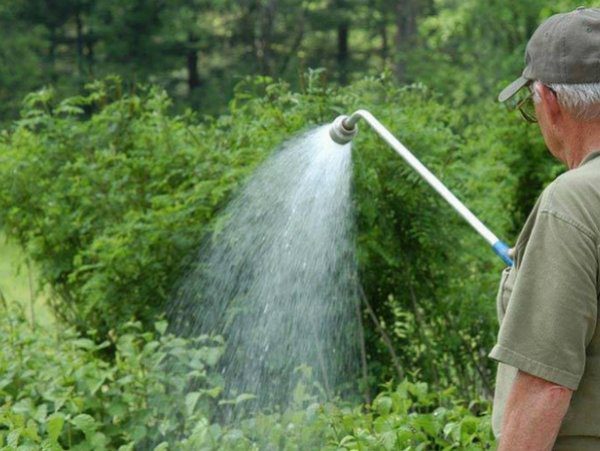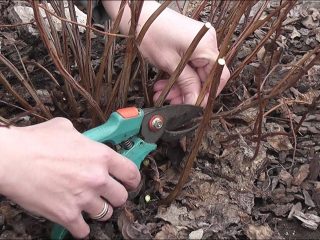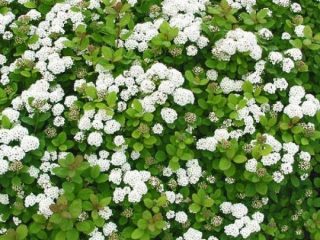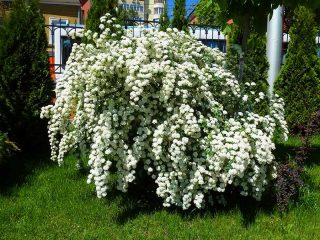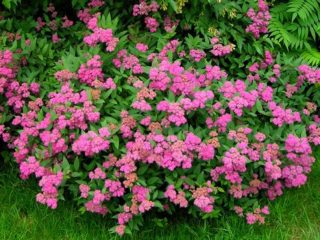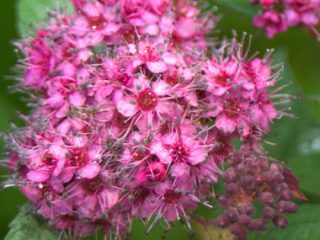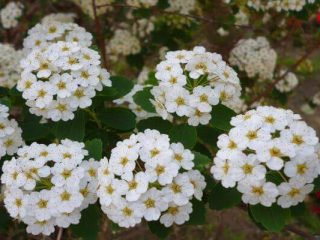Content
Spiraea gray Grefsheim is a deciduous shrub belonging to the Rosaceae family. The genus of these plants is quite extensive; they lend themselves to interspecific crossing without any particular difficulties. During the breeding experiment, two varieties were used: Zverobolistnaya and Belovato-gray. Thus, in 1949, a new hybrid species appeared in Norway - Spiraeacinerea Grefsheim.
Due to its extraordinary properties, it is used to decorate personal plots, gardens, and parks. Landscape designers prefer the Grefsheim hybrid for its aesthetics and versatility, and gardeners prefer it for its minimal care.
Description of spiraea sulfur
Spiraea gray Grefsheim is a branched, fast-growing, long-flowering shrub. Grows up to 2 m in height and width. At the same time, the crown is quite compact, spherical in shape. The shoots are branched, tomentose. The leaves are 4 cm long, 1 cm wide, lanceolate, pointed at the ends. The edges of the leaf plate are smooth. The plant received its name because of the gray tint of the leaves. Only in autumn do they turn yellow.
The Grefsheim spirea flower has a diameter of up to 1 cm. The terry petals are snow-white in color. There is a yellow center inside. All flowers are collected in umbrella inflorescences, which very densely cover the shoots. The flowering period begins in May and lasts 1.5 months. Afterwards, small fruits are formed on the Grefsheim hybrid.
Features of the Grefsheim gray spirea variety are:
- high growth, branches grow by 25 cm annually;
- good honey plant, attracts many pollinating insects to the site;
- drought and frost resistance, belongs to climate zone 4;
- tolerates haircut painlessly;
- resistance to urban smog and dust;
- unpretentiousness to lighting.
Spiraea gray in landscape design
In landscape design, gray spirea Grefsheim is used in different ways, it all depends on the imagination of the owner of the site or the designer. A hedge can be planted along paths or used as a fence, then it will simultaneously serve as a fence and decoration. It easily disguises garden supplies, be it watering barrels or equipment storage.
The Grefsheim hybrid is also used for single plantings. For example, in the center of a clearing with a lawn, near the porch, creating a bright accent for an alpine slide.The classic style involves planting spirea gray Grefsheim near bodies of water.
It is difficult to find plants with which Gray Spiraea Grefsheim would not go well. It looks great with low-growing ornamental shrubs: euonymus, broom, viburnum. You can plant the Grefsheim hybrid variety next to tulips, daffodils, primrose, and crocuses.
Varieties of gray spirea
Today, more than 100 varieties of spirea are known. They differ in size, flowering period, and color. Among the most popular varieties of gray spirea are ashy Grefsheim, gray Arguta, Graciosa, the external individual features of which can be seen in the photo.
Spiraea ashen Grefsheim
A shrub 1.5 m high. The crown of the plant, at first glance, resembles a snow-white ball. The spectacular Grefsheim hybrid is distinguished by its dense, constant presence of flowers. The leaves are ash green or bronze yellow. The color of the inflorescences can be pink, red, white. It is the most compact among other types.
Spiraea gray Arguta
Arguta has been known since 1884. The popular name is “Foam of May”. Covered with flowers in the second half of April. The crown is voluminous. Flowers are formed on last year's shoots, diameter 0.5-0.8 cm, color white. Belongs to climate zone 6. Gives preference to fertile soils. Photophilous culture. Looks good in combination with conifers.
Spiraea gray Graciosa
An elegant shrub with spreading, arched branches. Height 1.5-2 m. Leaves are narrow-lanceolate, green. Flowering is long and lush. The flowers are collected in umbrella inflorescences and are white in color. Unpretentious character. The subspecies has high drought and frost resistance.
Planting and caring for spirea sulfur
Grefsheim does not have any special requirements for planting and caring for gray spirea. You just need to take into account the recommendations described below.
Landing dates
Experienced gardeners say that it is best to plant Grefsheim sulfur spirea in the fall. When the trees lose their leaves, but it is not yet very cold. Approximately this is the second mid-September. Before the onset of frost, the seedling will have time to get stronger and settle in a new place, and with the arrival of warmer weather it will begin to grow.
Of course, Grefsheim spirea sulfur can be planted in open ground in the spring. Just have time before the buds open. It has been noted that seedlings of the Grefsheim hybrid take root best in rainy or cloudy weather.
Preparation of planting material and site
A well-chosen place makes it possible for Spiraea sulfur Grefsheim to grow for decades. The main requirement is good lighting. The planting area should be in a secluded corner, protected from cold winds and drafts. The description of the variety states that gray spirea Grefsheim is capable of growing in partial shade, but in this case the rate of development will slow down significantly. The sun should illuminate the area evenly, otherwise the crown will be one-sided.
The Grefsheim hybrid bush grows well in loose, light soils. Micronutrients are preferred. You can enrich depleted soil with the help of a turf substrate, humus, peat, and sand will add lightness to the soil. A neutral acidity level is also required. An equally important nuance for the full development of Spiraea sulfur Grefsheim is the organization of the drainage layer.
When purchasing a seedling of Grefsheim spirea sulfur, it is worth conducting a visual inspection. High-quality planting material does not have foliage, blackness or cuts.The roots are moist and flexible. If the plant is sold in a container, the root system should not emerge through the drainage holes. This indicates that the cutting is not fresh and will take a long time to take root.
Before planting Grefsheim hybrid seedlings, excess soil must be removed. If there are fossils, it is worth leaving them in a container of water for several hours. Be sure to carry out preparatory activities:
- shorten long and damaged roots;
- Reduce the size of shoots by 30% of the entire length.
How to plant gray spirea
When forming a recess, it is important to take into account that the size of an adult Grefsheim spirea bush has a fairly developed root system. The planting area will need to be large, and the dimensions of the pit will be twice the volume of the roots.
It is advisable to dig a hole a couple of days before the planting procedure, so that the walls of the hole have dried out.
- Crushed stone, expanded clay, and pebbles are laid at the bottom in a layer of 10-15 cm.
- A mixture of peat and turf soil is poured on top.
- A sulfur spirea seedling is placed in the center of the recess and the roots are carefully straightened.
- Sprinkle with earth and lightly compact.
- Pour 20 liters of warm water into the circle around the trunk.
- After moisture is absorbed, the tree trunk area is covered with mulch 5-10 cm thick.
The first flowering will occur 3-4 years after planting.
When planting Grefsheim bushes in groups, the distance is 0.8 m.
Watering and fertilizing
Like other varieties, gray spirea Grefsheim has a superficial root system.It reacts poorly to lack of moisture. The leaves immediately begin to wither and the growth rate slows down. But excess water will not be good for the Grefsheim hybrid. Constant exposure to a humid environment will cause the roots to rot.
To keep the water regime normal, it is enough to water the gray spirea Grefsheim twice a month, 15 liters per plant. During periods of prolonged absence of rain, the frequency of moisturizing should be increased and the procedure should be performed twice a week.
It is recommended to delight the Grefsheim spirea bush with nutrients several times a season.
- The first time the gray spirea is fertilized is after spring, preventative pruning, but before flowering begins. They use preparations containing nitrogen, which will stimulate the growth and expansion of green mass.
- The second time - during the budding period, to obtain beautiful and lush flowering. Potassium-phosphorus fertilizers are used for these purposes.
- The last time is after the end of flowering. It is preferable to use organic fertilizers, bird droppings or mullein with superphosphate.
Formation of spirea sulfur
The formation of spirea sulfur Grefsheim involves proper pruning of the bush. This procedure is quite complicated and can take several years. Every autumn, 5-6 strong, healthy shoots are selected, the rest are removed. After flowering, cut off weak branches. Thus, after 2-3 years only strong branches will remain, which will form the crown of the gray spirea.
Do I need to cover it for the winter?
The ability to withstand winter varies depending on the variety. Spiraea gray Grefsheim can withstand air temperatures down to – 50 °C without much loss.It follows from this that there is no need to provide shelter for the winter. The only thing that the bush does not like is sudden and frequent weather changes. Therefore, in cold areas, experts advise mulching the circle around the trunk.
Preparing gray spirea for winter
Young shoots may not tolerate the cold and die. In the northern regions of Siberia, in order to protect the gray spirea Grefsheim, further care should be carried out correctly after autumn planting.
- Cover the tree trunk circle with a 10 cm layer of dry leaves or grass.
- Gather the shoots into a bunch.
- Then bend the branches to the ground and secure them with a metal peg.
- The top is covered with village and straw.
- Compact with agrofibre or burlap.
Pruning spirea gray
Pruning is the main element of caring for spirea sulfur. It helps maintain the decorative properties of the shrub at the proper level, stimulates further growth and lush flowering.
When to prune gray spirea
The procedure is carried out in spring and autumn. After winter, dry, frozen branches are removed by performing sanitary pruning. The Grefsheim hybrid is characterized by rapid growth; soon new shoots appear in their place. The formation of many shoots gives density to the sulfur spirea bush.
As a rule, the second pruning of Grefsheim spirea is planned in the fall, after flowering. Lost and diseased branches are also removed, and other shoots are shortened. At this time, it is recommended to perform a rejuvenating haircut. Absolutely all branches are cut off, leaving a stump with dormant buds at the base. It is from them that young shoots will grow.
How to prune gray spirea after flowering
- The first cutting of spirea gray Grefsheim occurs 2 years after planting, not earlier.
- The branch develops up to 4 years, and then dries out. If you do not prune regularly, the bush will dry out.
- After the age of seven, a rejuvenation procedure is carried out, which involves pruning the branches at the root.
- The main pruning of the Grefsheim gray spirea shrub should be after flowering.
- Adults are trimmed by 25%, young ones have their branches shortened.
- You cannot leave shoots of only one age. In the future, gradual death will affect the appearance of the Grefsheim spirea shrub.
- After the first flowering, cut off weak shoots.
- If the main procedure is completed on time, namely in the fall, then in the summer the plant will delight you with beautiful flowering.
Reproduction of spiraea sulfur
Hybrid spirea gray reproduces in three main vegetative ways:
- dividing the bush;
- layering;
- cuttings.
How to propagate gray spirea from a bush
The division of the bush is carried out in the fall during the transplantation of spirea sulfur. The Grefsheim hybrid is carefully removed from the soil, the root system is cleaned to see the place of division. You need to divide the roots into 2-3 parts using garden pruners so that each part has two full-fledged shoots and a healthy lobe. If during the procedure it was necessary to damage their integrity, then it is better to immediately treat the area with a fungicide solution.
How to propagate by cuttings
Propagation of spirea sulfur Grefsheim is considered the simplest, most effective and popular way. Most gardeners practice this method. As a rule, preparations are made in September-October. Choose a one-year-old, healthy shoot. He must certainly be stiff and straight.Then cut into cuttings, each with 4-5 leaves. The main part of the greenery is removed, and the top is shortened by half.
Leave prepared petioles in Epin solution (1 ml per 2 liters of water) overnight. Then they are planted in wet sand. However, it is worth noting that the sprouts must be positioned at an angle of 45°. It is in this position that roots grow from the lower internode.
It is better to take the container with the planting out into the garden and cover it with a transparent cap. While the weather remains warm, spray the plants every other day. With the onset of frost, put an inverted box on top and cover it with dry leaves. In the spring, when shoots appear, gray spirea Grefsheim is transplanted into beds for growing.
How to propagate by seeds
Spiraea gray grefsheim is a hybrid variety. The seeds are not suitable for planting with further propagation. They do not carry genetic information. Therefore, the seed method is not suitable for breeding this variety.
How to propagate by layering
The layering method is easy to implement and is often in demand. In early spring, before the leaves appear, it is necessary to bend the side shoots to the ground. Deepen some of them a little. Along the length, the shoots of spirea gray Grefsheim are pinned with metal pegs. By autumn, a full-fledged root system usually appears. Therefore, you can separate the rooted shoot from the mother plant and replant it.
Diseases and pests
When growing a Grefsheim hybrid on a personal plot, there is a possibility of encountering uninvited guests, in particular, garden snails, aphids, and spider mites. They cause a lot of problems, so the gardener needs to regularly inspect the gray spirea Grefsheim. The earlier pests can be detected, the easier it will be to fight them.
For preventive purposes, they are treated with the biological preparation Fitoverm, which will destroy slugs when they appear and protect the plant from possible ailments.
Young shoots of the Grefsheim hybrid are attractive to aphids. Colonies of this insect inhabit the underside of the leaf and feed on the sap of branches and leaves. They can be eliminated using chemical treatment. Among the insecticides, Pirimor and Actellik have proven themselves well. Minor accumulations of aphids can be affected by infusion of wormwood, celandine, and hot pepper.
Spider mites cause serious damage to the Grefsheim hybrid. The plant takes on an unhealthy appearance, numerous holes are observed on the leaf plate, untimely yellowing and flying of leaves. Karbofos and Akrex products will help in the fight against spider mites.
In rare cases, Grefsheim spirea suffers from infections: ascochyta blight, septoria blight or ramularia blight. A large number of gray spots appear on the foliage. In this case, treatment will only help at the initial stage of the disease. When symptoms have just begun to appear, the Grefsheim hybrid should be treated with colloidal sulfur, Bordeaux mixture or Fundazol.
Conclusion
Spiraea gray Grefsheim is an aesthetically beautiful shrub that is easy to grow and attractive in appearance. It will fit perfectly into any landscape composition. At the same time, it will take a minimum of effort and time from the gardener, but will give white fireworks in the form of openwork, flowing shoots.
